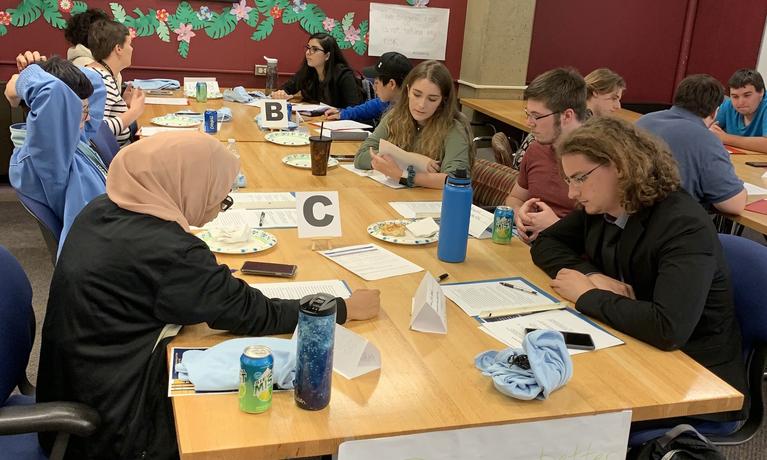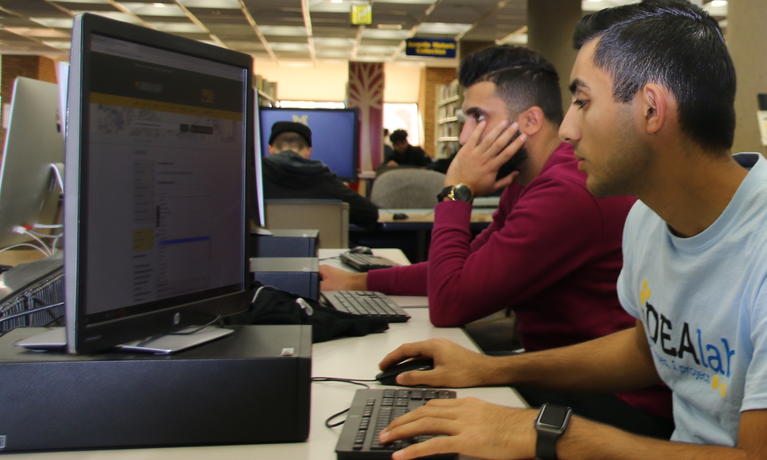
This article was originally published on October 29. 2019.
When Ali Almehdi has a research assignment, his go-to was “Google search.” But a new campus program — the IDEA Lab — is challenging how he conducts and carries out information gathering.
The IDEA Lab is an experiential learning initiative where three courses from three campus colleges work together on a community challenge. The overall goal? To problem solve by learning how to work well with people who have different skill sets and come up with a data-backed solution.
“Google can be a good place to start, but I’m learning that it doesn’t end there. I need to look in research journals to see what’s worked and talk to people to get their ideas,” says Almehdi, a bioengineering junior. “I have to be honest, it can be more frustrating than searching Google; people have a lot of opinions and we need to narrow it down to one solid idea. But I know the end result will be better and I’ll need to know how to do this in the future.”
IDEA Lab Director Maureen Linker says it’s all about developing career ready skills.
“We want to make sure that our students are prepared when they graduate and know how to solve challenges by asking all the right questions, empathizing and understanding the issues, and seeking out the right info to get answers needed,” she says.
To give a research foundation, Mardigian librarians, faculty and staff are working together to train nearly 60 students on how to find accurate detailed information from a variety of high-quality sources.

Students are encouraged to use designated library space and are connected with a research librarian who acts as an adviser. Each week, the librarians send students a Canvas announcement called “Chalk Talk” that includes an inspirational quote and suggests next steps as they move towards project completion.
To learn how to better collaborate, students are working in groups of five on a common problem. Each group is comprised of people in different majors planning to find employment in entirely different fields.
“I’m working with people who I didn’t know, who aren’t familiar with the same concepts that I am and who think differently than I do,” Almehdi says. “It can be hard, but that’s a good thing. To be a successful engineer — as someone who’s going to create prosthetics to help patients or machines needed in hospitals — I won’t just be talking to other engineers.”
And, best of all, the IDEA Lab was built into Almehdi’s course load.
Professors of the three class sections — Almehdi’s Engineering course, Applied Mechanics; an Education course, Education and Technology; and a Math course, Numerical Analysis — gave up two class sessions so their students could meet in the library to problem-solve in an interdisciplinary way and learn how to become better researchers in this opt-in program. Outside of those sessions, the library created an online area for the grouped students to work together and share information.
At the first IDEA Lab meeting in September, students were placed into groups and given a project that would help strengthen math education in the community. They’re going to assist the campus’ Maize and Blue Math Circle, a learning program that works with local youth, in having a broader reach in the Southeastern Michigan area.

Mathematics Associate Professor Yunus Zeytuncu says he began the Math Circles program six years ago as a small campus activity-based educational program for middle school students. It has grown into a major year-round initiative that includes UM-Dearborn faculty and students traveling to Detroit, Southfield, Ypsilanti and other communities to teach math.
“My Math Circles students who tutor or assist with the program mostly devote their time to daily operations. It’s difficult to have the time to think about more significant ideas to take the program to the next level. The IDEA Lab groups can do this part,” Zeytuncu says. “They are working on how to best improve our operation, which includes retention, recruitment, design and content.
“I’ve met with multiple IDEA Lab students; they reach out to me with questions. I am impressed with their interest and new ideas. They already started bringing valuable suggestions. We will use these observations, studies and recommendations to have a sustainable outreach program in mathematics.”
During that first meet-up, students also were given a design-thinking crash course, which provided a process on solving complex problems in a user-centered way. In early December, each group will present their unique data-backed ideas to Zeytuncu.
Looking at the ideas, one group is creating a promotional video — eye candy if you will — to get young students interested in this math program. Another wants to keep hands busy and develop fun online math activities. And Almehdi’s group has another approach: Brain fuel. They are looking at healthy, affordable bulk food to give to the participants during the two-hour sessions.
“We want something that’s easy-to-serve and economical, but with the benefits of nutrition — giving your body what it needs to keep your brain focused. Maybe with each snack we’ll even include a short description on how it helps you,” he says. “That way they’re learning about math and healthy eating. They might not need to eat or drink healthy now, but it will help in the long run.”
So far, Almehdi’s group did his go-to Google search. But after that, he spent time in the library looking up journal articles to learn more about programs that implemented healthy food options to see what they did and if participant performance increased.

Research Librarian Joan Martin says Almehdi is on the right track: Data gathered needs to go beyond a list of healthy snacks (that’s what comes up when you put those words into the Google search bar). Information should be collected on food vendors for pricing and on the audiences to see what communities you’d be serving. For example, pull statistics from Census data to see the population demographic; that can help you see if there may be community dietary restrictions.
“Whether it is a class or work project, you need more than a suggestion. You need data to back up what you are saying and a proposed plan on how it can be rolled out. That’s what we want to teach students,” Martin says.
Linker says the interdisciplinary pilot program shows promise on both sides of the challenge — for the student learners and the outreach partners. In the winter semester, three different courses will work together and collaborate with an off-campus group: Bike Dearborn.
But sitting in the library, Almehdi is focused on today. He’s searching the databases to prepare for the end-of-the-semester IDEA Lab project presentation. To him, it’s more than career- or research-skill sharpening — it’s a way he can make his community a better place.
“We are doing something that is going to help someone else. It’s not a hypothetical thing. It’s real,” he says. “To me, that’s the big motivator.”



